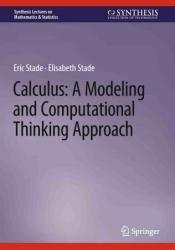Calculus: A Modeling and Computational Thinking Approach
- Добавил: literator
- Дата: 16-04-2023, 01:59
- Комментариев: 0
 Название: Calculus: A Modeling and Computational Thinking Approach
Название: Calculus: A Modeling and Computational Thinking ApproachАвтор: Eric Stade, Elisabeth Stade
Издательство: Springer
Серия: Synthesis Lectures on Mathematics & Statistics
Год: 2023
Страниц: 284
Язык: английский
Формат: pdf (true), epub
Размер: 22.3 MB
This book is intended for a first-semester course in calculus, which begins by posing a question: how do we model an epidemic mathematically? The authors use this question as a natural motivation for the study of calculus and as a context through which central calculus notions can be understood intuitively. The book’s approach to calculus is contextual and based on the principle that calculus is motivated and elucidated by its relevance to the modeling of various natural phenomena. The authors also approach calculus from a computational perspective, explaining that many natural phenomena require analysis through computer methods. As such, the book also explores some basic programming notions and skills.
And the programming, in turn, helps to elucidate the calculus. More specifically, the concept of a rate of change, which is perhaps the central idea of Calculus, is also at the heart of the “Euler’s method” algorithm that we use to solve the SIR equations. Familiarity with Euler’s method then promotes facility with rates of change. rogramming also requires certain linear, “computational” ways of thinking. Thus programming fulfills a role, in this book, that rigorous, formal proofs have sometimes played in earlier calculus texts. Of course, there’s nothing wrong with rigorous, formal proofs. They can be powerful things of beauty. But programming is a skill that has perhaps wider, more direct utility in life beyond Calculus.
All of the above perhaps suggests that this text is well off of the beaten path. This may be true in some respects. But this book does cover most of the “standard” calculus notions: derivatives; differentiation rules and formulas, linear, polynomial, trigonometric, exponential, and logarithmic functions; inverse functions; optimization; Riemann sums; antiderivatives; integration; the Fundamental Theorem of Calculus; integration by substitution; separation of variables; and so on. The approach is different, though: it’s contextual, and it’s computational.
Here and throughout this text, we present code written in the mathematical programming language know as Sage (or Sagemath). Sage is available for free use and has a web interface, and is therefore accessible and easy to use in the classroom. Our Sage code here is quite similar to what it would look like in other mathematical programming languages, like Mathematica, MATLAB, and so on.
Contents:
Скачать Calculus: A Modeling and Computational Thinking Approach
[related-news] [/related-news]
Внимание
Уважаемый посетитель, Вы зашли на сайт как незарегистрированный пользователь.
Мы рекомендуем Вам зарегистрироваться либо войти на сайт под своим именем.
Уважаемый посетитель, Вы зашли на сайт как незарегистрированный пользователь.
Мы рекомендуем Вам зарегистрироваться либо войти на сайт под своим именем.

